
Journal of Modern Physics, 2012, 3, 215-216
http://dx.doi.org/10.4236/jmp.2012.33029 Published Online March 2012 (http://www.SciRP.org/journal/jmp)
Review of the Book “Causality and Reversibility in
Irr eversible T ime”
A. N. Morozov
Physics Depa rtme nt, Bauman Moscow State Technical University, Moscow, Russia
Email: amor59@mail.ru
Received January 19, 2012; revised February 23, 2012; accepted March 4, 2012
ISBN: 978-1-935068-55-6
117pp Pub.Date: October/2011
Price: $89
The book concerns a number of the most fundamental
concepts and problems of modern physics: causality,
entanglement and the nature of time. A distinguishing
feature of author’s approach is equal attention to both th e
theoretical and experimental challenges posed by those
issues. From very beginning, in Introduction the author
points out Kozyrev causal mechanics, suggested about
fifty years ago, as an inspirable source of ideas devel-
oped him at the modern level of rigor.
Indeed, the progress in quantum mechanics has shed a
new light on Kozyrev ideas and his experimental results.
The possibility of observation of the future states as the
existing reality demonstrated by the scientist seems now
real. The quantum mechanical principle of weak causal-
ity, originally qualitativ ely su ggested by Cra mer and then
strictly formulated by Korotaev, (Chapter 3) admits
availability of the signals in reverse time for the random
processes. The series of experiments (Chapter 6) has re-
vealed availability of the advanced response in the lab
detectors to large-scale dissipative heliogeophysical pro-
cesses. The high level of advanced correlation and the
large time shift allowed to do the long-term forecasts of
geomagnetic and solar activity.
The author goes to these final results step-by-step
through the book. In Chapter 1 he considers direct de-
velopment of Kozyrev semiclassical theory and its geo-
physical application. As a result a number of well know
facts of planetary North-South asymmetry which seemed
occasional before turns out quite regular.
In Chapter 2 the author reconsider starting points of
causal mechanics and develops a new method of causal
analysis at the beginning at the classical level. The basic
idea of causal analysis lies in formalization of intuitive
understanding of the asymmetry of a cause and an effect
owing to which one can usually distinguish them without
measuring of retardation. In other words the essence of
causal analysis is based on formalization of cause and
effect concepts from informational asymmetry of the pro-
cesses without resort to time relation. The retardation of
effect relative to the cause variables is introduced after
their definition as an axiom. Althoug h the causal analysis
was first suggested by Korotaev in 1989 for solving of
fundamental problems (and in such a manner it is de-
scribed in the book) nowadays his method is employed
by different researchers as a very practical tool of ex-
perimental data processing.
Next in Chapter 3 quantum causal analy sis is considered.
Somebody believes that the quantum world is causeless.
It proved to be a particular case. Quantu m entangled sta-
tes can be causal and this causality is very interesting.
The outstanding distinction of quantum causality from
classical one is that the for mer can exist only in the mixed
states. In other words finite quantum causality is possib le
only in the open systems. Moreover quantum causality
admits time reversal, the consequences of which are con-
C
opyright © 2012 SciRes. JMP